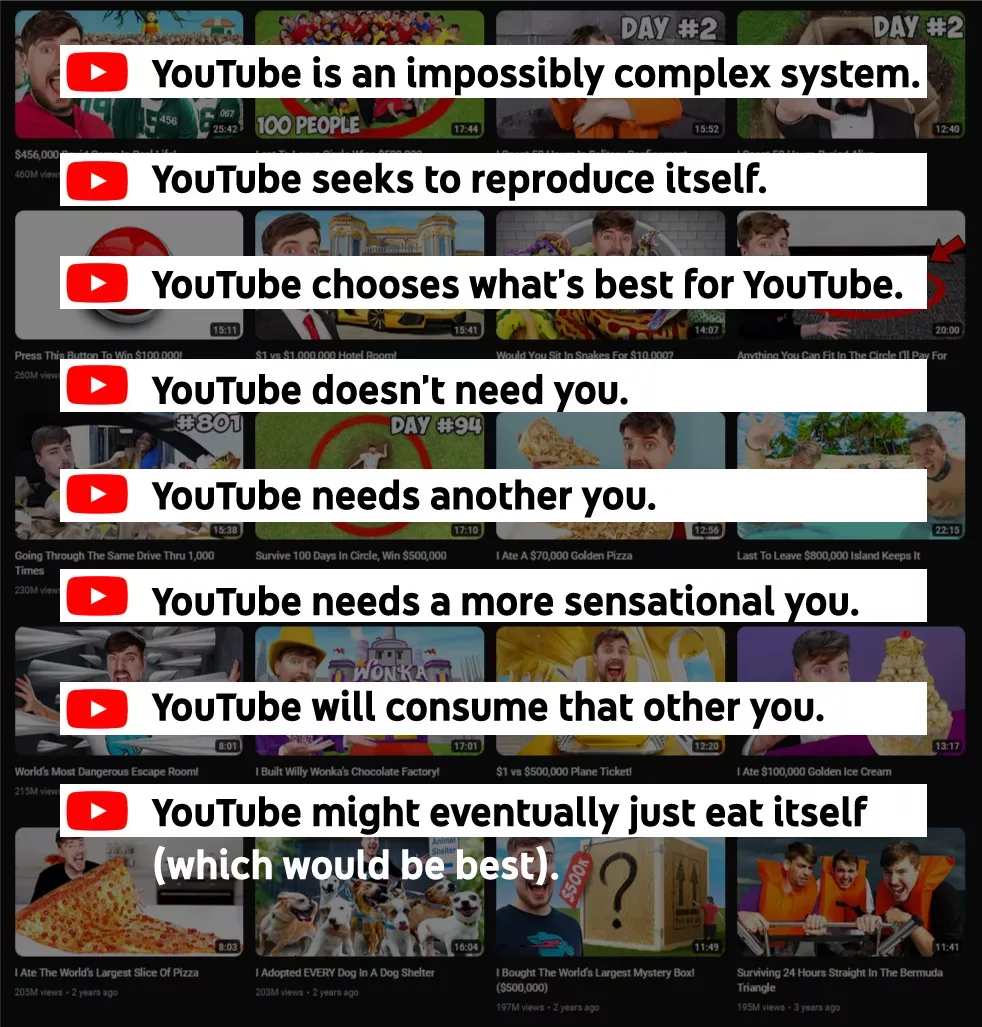CAVI RESOURCE HOME +++++ OUR REFLECTIONS +++++ HOW-TO +++++ COMMUNITY CONVERSATIONS

We started this project to connect to our community… to weave together a fabric of ideas made from the kindred producers making interesting videos about art online.
We were also curious as to what art organizations talk about when they talk about art.
We had hoped to create structures for navigating a section of the internet that somehow resisted an algorithmic experience. Our experiments show this might be possible, but the connections and conversations we had while experimenting suggest… no plead… that together we need to build alternatives.
Collective and collaborative projects like VUCAVU (a streaming platform for Canadian arts distributors) and Cube Commons (a new collective owned and operated arts education platform) are essential to the long term health and well being of the Canadian Cultural Sector. We will not topple the monocultural infrastructure of algorithmic video consumption, but we risk ecosystem collapse if there is no diversity. Not only diversity of content, but of platform management and information structure and recommendation systems– diversity in the deep dark soil from which things grow.

Here is the summary of what we have learned in all its complexity and contradiction:
YouTube (and TikTok and Reels and and and) are gambling games that pay out.
If you optimize to be machine readable and play the algorithm you and your organization may share in some of the winnings, but the house always wins in the end.
However, some of us must play.
Some of us must try to beat the house because we do not want these platforms to be absent of our perspectives and ideas.
Culture of today is made there as much as anywhere.
But we must also build alternatives to these casinos of culture.
And not just hope for a new casino with a new type of gambling but a collection of alternatives that show there are other ways to play, other ways to create, distribute and enjoy culture.
And most importantly we must do this together.

There is much to be said about the optimism of the early, more open, internet. It feels like we are in a striking moment, coming into a post-COVID world, fatigued by what network existence has become, we can be tempted by nostalgia for a pre-social media time.
However, as we look to the past we must be careful not to gaze with rose colored glasses. It is perhaps our optimism about digital life that enabled these new technological (and thus political) superpowers to become what they are.
There are, of course, many shifting elements to this post-COVID digital world. The rise of the Fediverse is putting new terms into the public imagination. If you can see through the smoke and mirrors of crypto culture one can see very exciting conversations about interoperability and governance and democracy happening in the blockchain space.
There are many important projects and thinkers working through new ideas of network life and the collective dimension to it. They are identifying the state of things, but also proposing alternatives.

Attempting to capture this current moment of digital mass culture and the metrics at its very core, art writer Ben Davis teases out the idea of ‘Quantitative Aesthetics’ here at artnet news.
For a startling dive into the possible future in which the complexity of the technology leads us into a a more opaque and uncertain existence, check out James Bridle’s 2017 work New Dark Age: Technology and the End of the Future.
For a combination of hard reality and pragmatic optimism see the incredible wok of Cory Doctorow (and his collaborators), particularly his recent non-fiction projects Chokepoint Capitalism: How Big Tech and Big Content Captured Creative Labor and How We Will Win Them Back (with Rebecca Giblin) which looks at the dire situation of monopolies (particularly in culture) and puts forward strategies for change, as well as The Internet Con: How to Seize the Means of Computation.
A few years ago HOLO magazine relaunched themselves with a combined dedication to web and physical publishing. HOLO.MG has a curated stream of art, design, tech and politics drawn from across the world as well as in-depth dossiers it develops in partnership with cutting edge cultural organizations including MUTEK, the Beall Center for Art and Technology and iMAL.
Attempting to unpack and interpret the media and cultural ecology of the 21st century, once aggregator and now hybrid Paetron driven podcast/discord community hybrid, New Models, and their founders Caroline Busta, Lil Internet, & Daniel Keller, is an incredible source of inspiration and conversation.
In 2022, Yancy Strickler (founder of Kickstarter) launched a new approach to cultural creation and distribution called Metalabel. Read about the ideas (purpose, principle, releases, information architecture, scene and funding) behind Metalabel here.
VUCAVU is a streaming platform bringing art works from Canadian distributors to the broad public, to presenters and programmers and to educational institutions. Seeking to adapt the 20th century distribution models for film and video art to the 21st century, VUCAVU has developed a multifaceted platform that centers artists and their work.
Cube Commons is a new platform developed to house video, audio and digital publications about art. It combines a web 2.0 usability with a new approach to the shared vision and governance of the platform. Artengine has been grateful to collaborate with the team and Cube Commons and work in partnership to develop complementary projects helping Canadian arts organizations.
221A, based in Vancouver, is a leader in cultural research, particularly in their efforts to blaze a trail through to the opportunities provided by blockchain technology. Check out their 5 year project Blockchains and Cultural Padlocks for insight and resources.